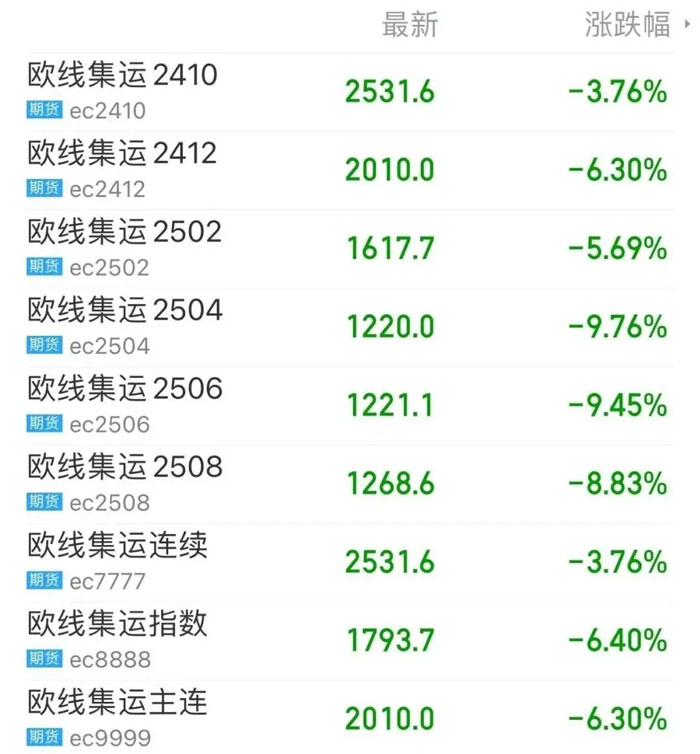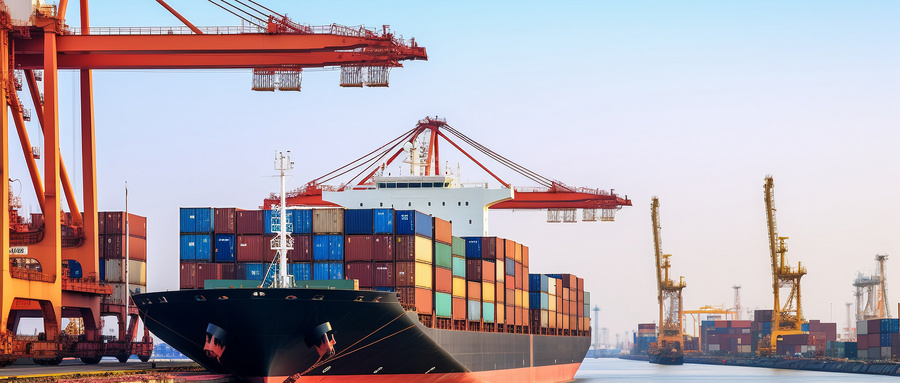

The main contract of the European line fell more than 15% during the day, and the spot freight rate accelerated to fall
On September 5, the main contract of the container index (European line) fell more than 15% during the day, and is now at 1723.0 points.
Weak market demand and lower spot freight rates: The demand in the container market has weakened significantly, resulting in an accelerated decline in spot freight rates. With the arrival of the off-season, freight demand has declined significantly, and shipping companies are facing huge pressure to solicit goods and fill tanks, which has triggered a fierce "price war" in the market. This price war situation has further exacerbated the rapid decline in freight rates, which has brought significant pressure to the consolidation plate.
▪ Expectations of geopolitical detente: Large demonstrations in Israel and strong calls for a ceasefire between the government and Hamas have renewed market expectations of a geopolitical detente. This expectation has had an indirect impact on the container shipping market, increasing market uncertainty and further putting pressure on the container shipping surface.
In general, the main pressure currently faced by the bulk freight plate is not only from the internal factors of insufficient market demand and rapid decline in freight rates, but also from external factors such as changes in the geopolitical situation.
The drop in spot freight rates accelerated
Freight rates have recently experienced a significant acceleration in the downward adjustment process. The specific performance is as follows:
▪ Sharp decline in freight rates: In early September, bulk container freight rates for European routes fell below the $6,000 mark, a drop of more than $900 compared with the end of August. In the middle of September, the freight rate further fell to $5,500, and even appeared lower than the market average price such as the $4,808 reported by ONE company on Friday, showing the acceleration of the pace of price reduction and the expansion of the decline.
▪ A number of shipping companies to adjust their rates: The latest online freight data shows that a number of major shipping companies have lowered their rates. Cma CGM lowered its freight rates in mid-to-late September to $2,980 /TEU and $5,560 /FEU, a reduction of more than 10%; Hanshin Shipping's September booking rate also continued to drop to $2,800 /TEU and $5,180 /FEU, the same decrease of about 10%. Even COsco Shipping, whose prices are relatively stable, has lowered its freight rates in mid-early September, with small and large containers down 13% and 17%, respectively, to $4,275 /TEU and $6,225 /FEU.
▪ Overall market expectations: According to statistics, the average price of small cabinets in September is estimated at $3,300, and the average price of large cabinets is $5,700. This expectation reflects the market's general view of the continued decline in freight rates.
▪ Weak market demand: Behind the sharp reduction in freight rates is the apparent weakness of market demand. In the early part of September, the market booking situation is not good, and the cargo volume is significantly reduced compared with the previous period. Some shippers, especially low value shippers, chose to delay shipments due to further bearish expectations on freight rates. In addition, the freight rate from northern ports (such as Tianjin Port) to basic ports in Europe is lower than that of southern ports (such as Shanghai Port), which also reflects the imbalance of market supply and demand to a certain extent.
Consolidation market Outlook: The interwoven influence of geopolitical situation, supply and demand changes and seasonal demand
In the spot market, the trend of accelerating downward freight rates is becoming more obvious. The freight rate of the large container on the European route has fallen below the key psychological price, and the price war between the shipping companies has intensified, further aggravating the pessimistic mood of the market. Market analysis believes that the death of detained personnel makes the already difficult ceasefire negotiations more complicated, and the geopolitical tension directly affects the stable operation of the container market.
However, despite the short-term impact of geopolitical events on the market, the trading logic of the container forward month contract is gradually returning to fundamentals.
From the perspective of far-month contracts, the capacity supply gap caused by the core impact of geopolitical conflicts on European freight rates - circumnavigation is gradually being filled with the continuous delivery of a large number of new ships between 2024 and 2025. This trend means that the marginal impact of the geopolitical conflict is gradually diminishing, and the trading of far-month contracts will return more to the track of supply and demand fundamentals of the shipping market. Therefore, the recent news dynamics around the geopolitical situation, the impact on the surface of the container futures, in terms of degree and continuity, has shown a weakening trend.
Looking forward to the future market, the trend of container shipping futures will closely revolve around the changes in the supply and demand fundamentals of the shipping market and the adjustment of spot freight rates. It is worth noting that although historical data shows that shippers often try to increase freight rates before the National Day holiday, whether they can successfully raise prices this year will be highly dependent on the actual performance of market volumes. On the supply side, the easing of global port congestion has released some capacity, and the continued delivery of new ships has kept overall capacity supply at a high level.
Under the dual role of both supply and demand, the spot freight rate in the fourth quarter is facing greater downward pressure. The market generally believes that the small container freight rate is likely to return to around $2,000, while the large container freight rate may fall to about $4,000, which is expected to correspond to the underlying index of about 2,400 points. At the same time, considering the expansion of the current discount phenomenon, the convergence of the future basis may set a certain limit on the further decline of the price.
In addition, seasonal demand factors cannot be ignored. With the approach of Christmas and New Year's Day, the market is expected to usher in a round of concentrated shipment demand, which may bring certain support to the bulk market. Therefore, for the main contract EC2412, although the overall trend is bearish, it is also prudent to be overly bearish. Investors should pay close attention to market dynamics and adjust their strategies flexibly in response to possible changes.


Weak market demand and lower spot freight rates: The demand in the container market has weakened significantly, resulting in an accelerated decline in spot freight rates. With the arrival of the off-season, freight demand has declined significantly, and shipping companies are facing huge pressure to solicit goods and fill tanks, which has triggered a fierce "price war" in the market. This price war situation has further exacerbated the rapid decline in freight rates, which has brought significant pressure to the consolidation plate.
▪ Expectations of geopolitical detente: Large demonstrations in Israel and strong calls for a ceasefire between the government and Hamas have renewed market expectations of a geopolitical detente. This expectation has had an indirect impact on the container shipping market, increasing market uncertainty and further putting pressure on the container shipping surface.
In general, the main pressure currently faced by the bulk freight plate is not only from the internal factors of insufficient market demand and rapid decline in freight rates, but also from external factors such as changes in the geopolitical situation.
The drop in spot freight rates accelerated
Freight rates have recently experienced a significant acceleration in the downward adjustment process. The specific performance is as follows:
▪ Sharp decline in freight rates: In early September, bulk container freight rates for European routes fell below the $6,000 mark, a drop of more than $900 compared with the end of August. In the middle of September, the freight rate further fell to $5,500, and even appeared lower than the market average price such as the $4,808 reported by ONE company on Friday, showing the acceleration of the pace of price reduction and the expansion of the decline.
▪ A number of shipping companies to adjust their rates: The latest online freight data shows that a number of major shipping companies have lowered their rates. Cma CGM lowered its freight rates in mid-to-late September to $2,980 /TEU and $5,560 /FEU, a reduction of more than 10%; Hanshin Shipping's September booking rate also continued to drop to $2,800 /TEU and $5,180 /FEU, the same decrease of about 10%. Even COsco Shipping, whose prices are relatively stable, has lowered its freight rates in mid-early September, with small and large containers down 13% and 17%, respectively, to $4,275 /TEU and $6,225 /FEU.
▪ Overall market expectations: According to statistics, the average price of small cabinets in September is estimated at $3,300, and the average price of large cabinets is $5,700. This expectation reflects the market's general view of the continued decline in freight rates.
▪ Weak market demand: Behind the sharp reduction in freight rates is the apparent weakness of market demand. In the early part of September, the market booking situation is not good, and the cargo volume is significantly reduced compared with the previous period. Some shippers, especially low value shippers, chose to delay shipments due to further bearish expectations on freight rates. In addition, the freight rate from northern ports (such as Tianjin Port) to basic ports in Europe is lower than that of southern ports (such as Shanghai Port), which also reflects the imbalance of market supply and demand to a certain extent.
Consolidation market Outlook: The interwoven influence of geopolitical situation, supply and demand changes and seasonal demand

In the spot market, the trend of accelerating downward freight rates is becoming more obvious. The freight rate of the large container on the European route has fallen below the key psychological price, and the price war between the shipping companies has intensified, further aggravating the pessimistic mood of the market. Market analysis believes that the death of detained personnel makes the already difficult ceasefire negotiations more complicated, and the geopolitical tension directly affects the stable operation of the container market.
However, despite the short-term impact of geopolitical events on the market, the trading logic of the container forward month contract is gradually returning to fundamentals.
From the perspective of far-month contracts, the capacity supply gap caused by the core impact of geopolitical conflicts on European freight rates - circumnavigation is gradually being filled with the continuous delivery of a large number of new ships between 2024 and 2025. This trend means that the marginal impact of the geopolitical conflict is gradually diminishing, and the trading of far-month contracts will return more to the track of supply and demand fundamentals of the shipping market. Therefore, the recent news dynamics around the geopolitical situation, the impact on the surface of the container futures, in terms of degree and continuity, has shown a weakening trend.
Looking forward to the future market, the trend of container shipping futures will closely revolve around the changes in the supply and demand fundamentals of the shipping market and the adjustment of spot freight rates. It is worth noting that although historical data shows that shippers often try to increase freight rates before the National Day holiday, whether they can successfully raise prices this year will be highly dependent on the actual performance of market volumes. On the supply side, the easing of global port congestion has released some capacity, and the continued delivery of new ships has kept overall capacity supply at a high level.
Under the dual role of both supply and demand, the spot freight rate in the fourth quarter is facing greater downward pressure. The market generally believes that the small container freight rate is likely to return to around $2,000, while the large container freight rate may fall to about $4,000, which is expected to correspond to the underlying index of about 2,400 points. At the same time, considering the expansion of the current discount phenomenon, the convergence of the future basis may set a certain limit on the further decline of the price.
In addition, seasonal demand factors cannot be ignored. With the approach of Christmas and New Year's Day, the market is expected to usher in a round of concentrated shipment demand, which may bring certain support to the bulk market. Therefore, for the main contract EC2412, although the overall trend is bearish, it is also prudent to be overly bearish. Investors should pay close attention to market dynamics and adjust their strategies flexibly in response to possible changes.





